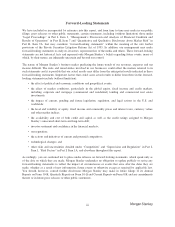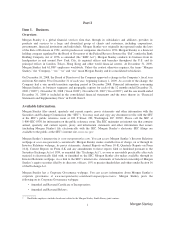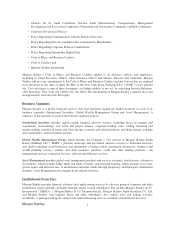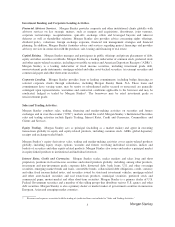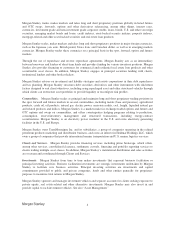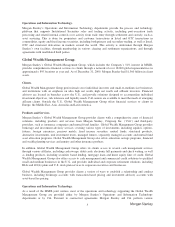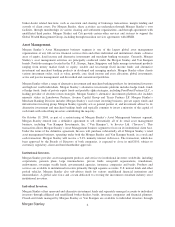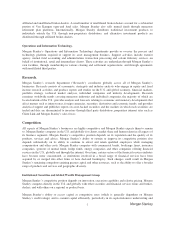Morgan Stanley 2009 Annual Report Download - page 14
Download and view the complete annual report
Please find page 14 of the 2009 Morgan Stanley annual report below. You can navigate through the pages in the report by either clicking on the pages listed below, or by using the keyword search tool below to find specific information within the annual report.
Morgan Stanley believes that most of the activities it conducted before becoming a financial holding company
remain permissible. In addition, the BHC Act gives Morgan Stanley two years after becoming a financial holding
company to conform its existing nonfinancial activities and investments to the requirements of the BHC Act with
the possibility of three one-year extensions for a total grace period of up to five years. The BHC Act also
grandfathers any “activities related to the trading, sale or investment in commodities and underlying physical
properties,” provided that Morgan Stanley conducted any of such activities as of September 30, 1997 and
provided that certain other conditions that are within Morgan Stanley’s reasonable control are satisfied. In
addition, the BHC Act permits the Fed to determine by regulation or order that certain activities are
complementary to a financial activity and do not pose a risk to safety and soundness.
It is possible that certain of Morgan Stanley’s existing activities will not be deemed to be permissible financial
activities, or incidental or complementary to such activities or otherwise grandfathered. If so, Morgan Stanley
may be required to divest them before the end of the original two-year or subsequent one-year grace periods
discussed above. Morgan Stanley does not believe that any such required divestment will have a material adverse
impact on its financial condition or results of operations.
Consolidated Supervision. As a financial holding company, Morgan Stanley is subject to the comprehensive,
consolidated supervision and regulation of the Fed. This means that Morgan Stanley is, among other things,
subject to the Fed’s risk-based and leverage capital requirements and information reporting requirements for
bank holding companies. The Fed has the authority to conduct on-site examinations of Morgan Stanley and any
of its affiliates, subject to coordinating with any state or federal functional regulator of any particular affiliate.
In order to maintain Morgan Stanley’s status as a financial holding company, its depository institution
subsidiaries must remain well capitalized and well managed. Reform proposals would also base such financial
holding company status on maintaining a well capitalized and well managed standard at the Morgan Stanley
holding company level. If designated a systemically important firm, Morgan Stanley would be required, pursuant
to such reform proposals, to remain well capitalized and well managed at all times. Under current regulations
implemented by the Fed, if any depository institution controlled by a financial holding company no longer meets
certain capital or management standards, the Fed may impose corrective capital and/or managerial requirements
on the parent financial holding company and place limitations on its ability to make acquisitions or otherwise
conduct the broader financial activities permissible for financial holding companies. In addition, as a last resort if
the deficiencies persist, the Fed may order a financial holding company to cease the conduct of or to divest those
businesses engaged in activities other than those permissible for bank holding companies that are not financial
holding companies. The regulations also provide that if any depository institution controlled by a financial
holding company fails to maintain a satisfactory rating under the Community Reinvestment Act of 1977, the Fed
must prohibit the financial holding company and its subsidiaries from engaging in any additional activities other
than those permissible for bank holding companies that are not financial holding companies.
Capital Standards. The Basel Committee and the Fed are rethinking the scope, strength and nature of the
capital requirements that should apply to global financial institutions like Morgan Stanley.
The Basel Committee has opened a broad-based consultation on capital, liquidity and leverage ratios that is
expected to be complete by the end of 2010, with implementation for most measures by the end of 2012, and in
some cases earlier. The results of this consultation, in the form eventually implemented into U.S. law by the Fed
and other U.S. banking regulators, are expected, among other aspects, to increase requirements as to the quality
of capital, with greater emphasis on common stock as the predominant form of capital, to enhance capital
requirements for trading book exposures, securitizations and counterparty credit risk exposure, to institute capital
conservation measures and liquidity coverage requirements, and to implement on a more global basis the
leverage ratio concept, a version of which is currently applied only by U.S. regulators. The exact scope and scale
of these capital changes are currently not known. Even under current standards, the Fed generally requires
Morgan Stanley and its peer financial holding companies to maintain risk-based and leverage capital ratios
substantially in excess of mandated minimum levels, depending upon general economic conditions and their
particular condition, risk profile and growth plans.
10


